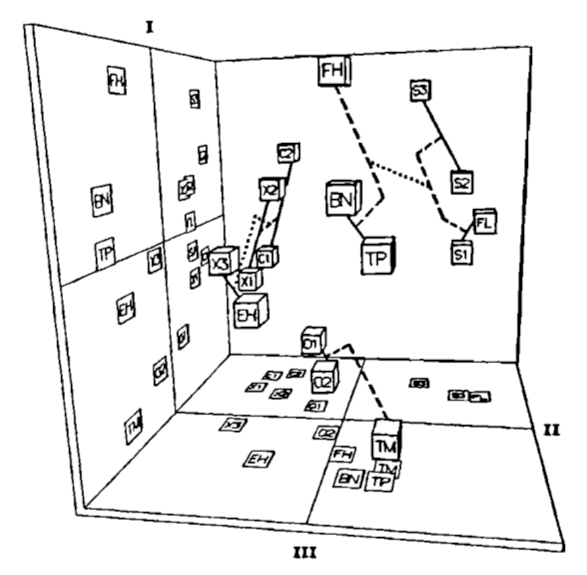
This is the timbre space from Grey (1977) "Multidimensional Perceptual Scaling of Musical Timbres." It was obtained by using multidimensional scaling to reduce the similarity judgments of subjects about stimulus tones with different timbres into a 3-dimensional space.
Roughly interpreted, Axis I characterizes spectral energy distribution, from narrow and low to broad and high; Axis II is related to the synchronicity with which harmonics enter and exit the tone together; Axis III also relates to the temporal dynamics of harmonics, characterizing something like presence or absence of low amplitude, high frequency overtones during the attack.
The stimuli were artificially synthesized in order to control for volume and duration. They were based on samples of actual instruments, however, in order to preserve realistic harmonic dynamics. Key: O1, O2: oboes; C1, C2: clarinets; X1, X2, X3: saxophones; EH: English horn; FH: French horn; S1, S2, S3: strings; TP: trumpet; TM: trombone; FL: flute; BN: bassoon.
Timbre Spaces II
Unfortunately, it's difficult to engage in the process of analyzing an uninterpreted timbre space without a starting point of some kind to get one's intuitions going.
Consider, for example, the timbre space on the left from Grey (1977). In the attempt to describe the dimensions recovered after multidimensional scaling, Grey follows Helmholtz's theory of timbre, which equates timbre with the spectral composition of the sound, i.e. the pattern of overtones which it comprises. Assuming the Helmholtz theory gives Grey a starting point for describing these dimensions, but leaves the descriptions awkward and counterintuitively complex (see sidebar).
What Grey's study does not provide is a description of his timbral dimensions in perceptual / phenomenological terms: just what perceptual feature does "presence of low amplitude, high frequency overtones during the attack" correspond to?
Another mystery (and perhaps a clue as well) are the discrepancies in the clustering of timbres in Grey's analysis and the familiar instrumental families assumed to be alike in timbre. For instance, flutes are grouped with the strings, while the bassoon is grouped with the brass. Does this discrepancy tell us the familiar categories are based in part on convention and are crosscut by perceptual similarities? Or does it point to a flaw in Grey's methods or analysis?
Grey's methodology motivates his adherence to the Helmholtz analysis and his ultimate description of timbral categories in physical rather than psychological terms. In particular, he prepared his stimuli by analyzing the spectral composition of recordings of the various instruments, but his input from subjects was purely in terms of judgments of similarity or difference. So, the only detailed descriptions of the points in the timbre space from which to derive a description of its axes were in Helmholtzian terms. In order to correlate a physical analysis such as Grey's with psychological categories, a different methodology must be applied.
More soon . . . .